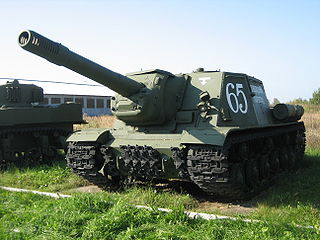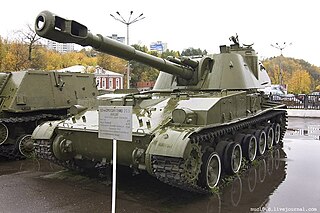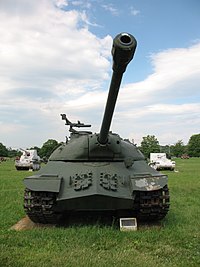
The T-72 is a family of Soviet/Russian main battle tanks that entered production in 1969. The T-72 was a development of the T-64, which was troubled by high costs and its reliance on immature developmental technology. About 25,000 T-72 tanks have been built, and refurbishment has enabled many to remain in service for decades. The early T-72 versions are considered as second-generation main battle tanks. It was widely exported and saw service in 40 countries and in numerous conflicts. The T-90 introduced in 1992 is a relatively minor development of the T-72B, though production and development of the T-72 continues today.

The IS tanks were a series of heavy tanks developed as a successor to the KV-series by the Soviet Union during World War II. The IS acronym is the anglicized initialism of Joseph Stalin. The heavy tanks were designed with thick armor to counter German 88 mm guns and carried a main gun capable of defeating Panzer IV tanks. They were mainly designed as breakthrough tanks, firing a heavy high-explosive shell that was useful against entrenchments and bunkers. The IS-2 went into service in April 1944 and was used as a spearhead by the Red Army in the final stage of the Battle of Berlin. The IS-3 served on the Chinese-Soviet border, the Hungarian Revolution, the Prague Spring and on both sides of the Six-Day War. The series eventually culminated in the T-10 heavy tank.

The T-62 is a Soviet main battle tank that was first introduced in 1961. As a further development of the T-55 series, the T-62 retained many similar design elements of its predecessor including low profile and thick turret armour. In contrast with previous tanks, which were armed with rifled tank guns, the T-62 was the first production tank armed with a smoothbore tank gun that could fire APFSDS rounds at higher velocities. While the T-62 became the standard tank in the Soviet arsenal, it did not fully replace the T-55 in export markets due to its higher manufacturing costs and maintenance requirements compared to its predecessor. Although the T-62 was replaced in Russia and the successor states of the Soviet Union, it is still used in some countries and its design features became standardised in subsequent Soviet and Russian mass-produced tanks.

The BT-7 was the last of the BT series of Soviet cavalry tanks that were produced in large numbers between 1935 and 1940. It was lightly armoured, but reasonably well-armed for the time, and had much better mobility than other contemporary tank designs. The BT tanks were known by the nickname Betka from the acronym, or its diminutive, Betushka.

The Panzerkampfwagen III, commonly known as the Panzer III, was a medium tank developed in the 1930s by Germany, and was used extensively in World War II. The official German ordnance designation was Sd.Kfz. 141. It was intended to fight other armoured fighting vehicles and serve alongside and support the similar Panzer IV, which was originally designed for infantry support. However, as the Germans faced the formidable T-34, more powerful anti-tank guns were needed, and since the Panzer IV had more development potential with a larger turret ring, it was redesigned to mount the long-barrelled 7.5 cm KwK 40 gun. The Panzer III effectively swapped roles with the Panzer IV, as from 1942 the last version of Panzer III mounted the 7.5 cm KwK 37 L/24 that was better suited for infantry support. Production of the Panzer III ceased in 1943. Nevertheless, the Panzer III's capable chassis provided hulls for the Sturmgeschütz III assault gun until the end of the war.

The SU-100 was a Soviet tank destroyer armed with the D-10S 100 mm anti-tank gun in a casemate superstructure. It was used extensively during the last year of World War II and saw service for many years afterwards with the armies of Soviet allies around the world.

The ISU-152 is a Soviet self-propelled gun developed and used during World War II. It was unofficially nicknamed zveroboy in response to several large German tanks and guns coming into service, including Tigers and Panthers. Since the ISU-152's gun was mounted in a casemate, aiming it was awkward, and had to be done by repositioning the entire vehicle using the tracks. Therefore, it was used as mobile artillery to support more mobile infantry and armor attacks. It continued service into the 1970s and was used in several campaigns and countries.

The M3 Stuart, officially Light Tank, M3, was an American light tank of World War II. An improved version entered service as M5. It was supplied to British and other Commonwealth forces under lend-lease prior to the entry of the U.S. into the war. Thereafter, it was used by U.S. and Allied forces until the end of the war.

The M3 Lee, officially Medium Tank, M3, was an American medium tank used during World War II. The turret was produced in two forms, one for US needs and one modified to British requirements to place the radio next to the commander. In British Commonwealth service, the tank was called by two names: tanks employing US pattern turrets were called "Lee", named after Confederate general Robert E. Lee, while those with British pattern turrets were known as "Grant", named after Union general Ulysses S. Grant.

The PT-76 is a Soviet amphibious light tank that was introduced in the early 1950s and soon became the standard reconnaissance tank of the Soviet Army and the other Warsaw Pact armed forces. It was widely exported to other friendly states, like India, Iraq, Syria, North Korea and North Vietnam.

The Type 97 Chi-Ha was a medium tank used by the Imperial Japanese Army during the Second Sino-Japanese War, the Battles of Khalkhin Gol against the Soviet Union, and the Second World War. It was the most widely produced Japanese medium tank of World War II.

The Turán was a Hungarian medium tank of World War II. It was inspired by and used the technology-based solutions found on the design of the Czechoslovak Škoda T-21 medium tank prototype, it was produced in two main variants: the 40M Turán with a 40 mm gun and the 41M Turán with a 75 mm gun. A total of 424 were made.

The BTR-70 is an eight-wheeled armored personnel carrier originally developed by the Soviet Union during the late 1960s under the manufacturing code GAZ-4905. On August 21, 1972, it was accepted into Soviet service and would later be widely exported. Large quantities were also produced under license in Romania as the TAB-77.

The Type 95 Ha-Gō was a light tank used by the Empire of Japan during the Second Sino-Japanese War, at Nomonhan against the Soviet Union, and in the Second World War. It proved sufficient against infantry but, like the American M3 Stuart light tank, was not designed to combat other tanks. Approximately 2,300 were produced, making it the most numerous Japanese armoured fighting vehicle of the Second World War.

The Sherman M-50 and the Sherman M-51, both often referred to abroad as the Super Sherman, were modified versions of the American M4 Sherman tank that served with the Israel Defense Forces from the mid-1950s to early 1980s. The M-51 was also referred to as the Isherman. However, the nicknames "Super Sherman" and "Isherman" were never officially used by the Israeli Defense Forces.

The Moscow Victory Parade of 1945 also known as the Parade of Victors was a victory parade held by the Soviet Armed Forces after the defeat of Nazi Germany. This, the longest and largest military parade ever held on Red Square in the Soviet capital Moscow, involved 40,000 Red Army soldiers and 1,850 military vehicles and other military hardware. The parade lasted just over two hours on a rainy June 24, 1945, over a month after May 9, the day of Germany's surrender to Soviet commanders.

This article deals with Sherman tanks extensive use around the world after World War II and catalogues foreign post–World War II use and conversions of Sherman tanks and variants based on the Sherman chassis.

The SO-152 is a Soviet 152.4 mm self-propelled gun developed in 1968. It was a response to the American 155 mm M109. The development started in 1967 according to the Resolution of the Council of Ministers of the Soviet Union from July 4, 1967. In 1968 the SO-152 was completed and in 1971 entered service. Its GRAU designation is 2S3 (2С3). The fighting vehicle also received the additional designation Akatsiya (Акация), which is Russian for Acacia.
This article deals with the history and development of tanks of the Soviet Union and its successor state Russian Federation from their first use after World War I, into the interwar period, during World War II, the Cold War and modern era.

The IS-2 is a Soviet heavy tank, the first of the IS tank series named after the Soviet leader Joseph Stalin. It was developed and saw combat during World War II, and saw service in other Soviet allied countries after the war.






















